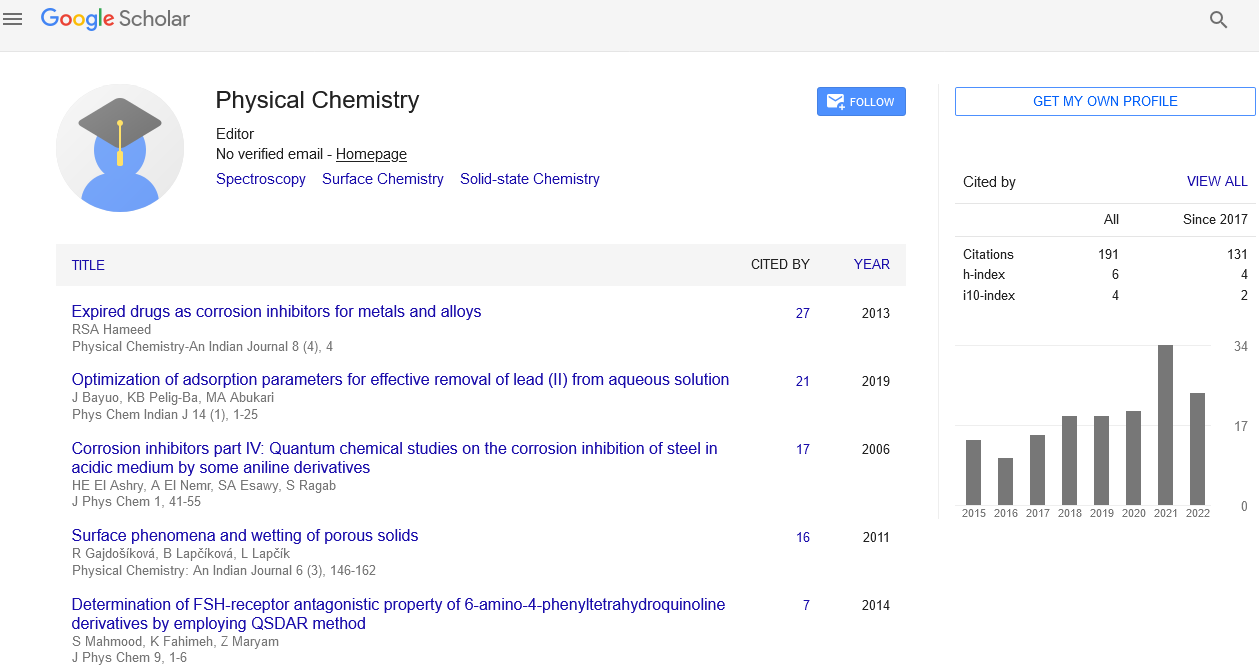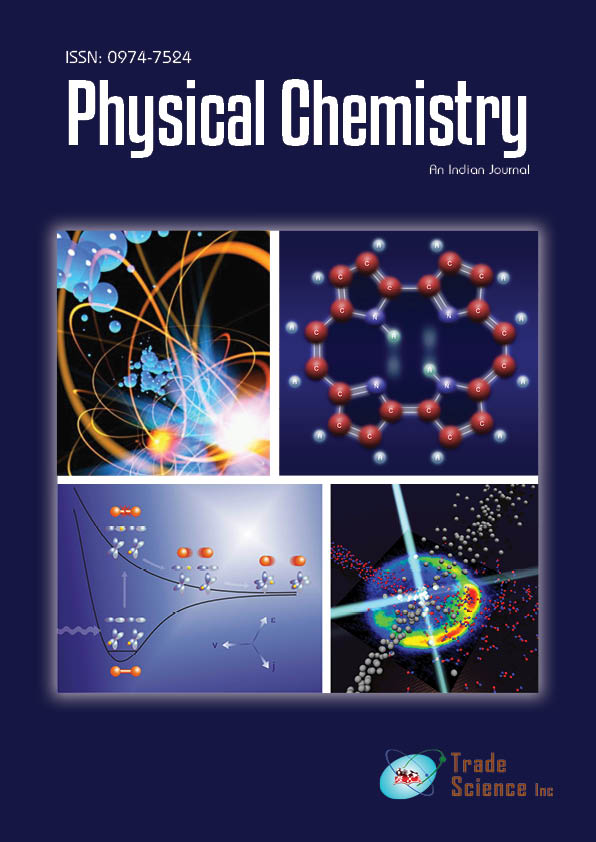Short commentary
, Volume: 18( 2)Chemistry and Diagnostics for a Holistic Approach to Transportation and Energy Conversion: Clean Combustion
Chemistry and Diagnostics for a Holistic Approach to Transportation and Energy Conversion: Clean Combustion Dakshita Mehra1 *, Chiranjeev Bisht2 1Department of Biochemistry, Govind Ballabh Pant University of Technology and Agriculture, Pantnagar, Uttarakhand, India 2Department of Chemistry, MBPG college, Haldwani, Uttarakhand, India *Corresponding author: Dakshita Mehra, Department of Biochemistry, Govind Ballabh Pant University of Technology and Agriculture, Pantnagar, Uttarakhand, India Received date: August 17, 2022, Manuscript No. M- tspc-22-79959; Editor assigned: August, 19, 2022, PreQC No. P- tspc-22-79959; Reviewed: October 7, 2022, QC No. tspc-22-79959; Revised: October 12, 2022, Manuscript No. R- tspc-22-79959; Published date: October 15, 2022, DOI: 10.37532/2320–6756.2022.17(5).
Abstract
This viewpoint piece aims to highlight potential and stimulate conversation about some recent advancements in the field of combustion. It doesn't promise to be exhaustive and only expresses the author's opinions. It is hoped that the topics and issues covered in this article would encourage increased communication and teamwork in the direction of more effective procedures and lower combustion emissions. According to the author, combustion science is well positioned to assist in the development of technologies for an integrated, sustainable future energy system because it combines the disciplines of chemistry, fluid dynamics, metrology, and high-performance computing with a variety of real-world applications in energy, transportation, and industrial production.
Abstract This viewpoint piece aims to highlight potential and stimulate conversation about some recent advancements in the field of combustion. It doesn't promise to be exhaustive and only expresses the author's opinions. It is hoped that the topics and issues covered in this article would encourage increased communication and teamwork in the direction of more effective procedures and lower combustion emissions. According to the author, combustion science is well positioned to assist in the development of technologies for an integrated, sustainable future energy system because it combines the disciplines of chemistry, fluid dynamics, metrology, and high-performance computing with a variety of real-world applications in energy, transportation, and industrial production. Keywords: Secondary Organic Aerosol (SOA); High-energy-density liquid fuels; Oxymethylene ethers; Dimethyl Ether (DME)
Role of Combustion The environment, climate, and human health are all significantly impacted by emissions from combustion processes [1,2]. They raise concerns about severe smog in urban areas and anthropogenic carbon dioxide production [3,4]. Today, fossil fuels account for more than 80% of all primary energy use worldwide. There are trends toward introducing fuels that are not derived from fossil fuels, but high-energy-density liquid fuels are essential for transportation. Technical viability of a fully renewable energy source based on the sun, water, and wind is indicated [5], with temporal fluctuations being the main issue. Additionally, chemistry-related research into capturing and storing renewable energy is advancing. Despite this, the amount of CO2 emitted globally increased from roughly 22 Gt in 1990 to 36 Gt in 2015 [3]. Anthropogenic fossil fuel contributions to CO2 emissions, which were close to 94% in 2015 [3], are not anticipated to decrease significantly in the face of rising global energy demand [1,2,4]. However, there are other important issues related combustion emissions besides carbon dioxide. Black carbon, for instance, particulate matter or soot from controlled combustion and open burning is reported to be among the most significant global health hazard factors [6,7], contributing notably to risks like diseases of the respiratory and cardiovascular systems. Black carbon is also associated with significant climate impact and is thought to have an adverse effect on human health [8]. Efficient and Good Fuels The benchmark used to discuss future transportation fuels is the current liquid petroleum-based fuels. However, the issue of what the best fuels of the future will be is still up for debate. The best answers will depend on a variety of factors, including scientific knowledge of their use and effects, energy density, toxicity, water solubility, emissions, availability, economic viability, adaptation to existing infrastructure, ease of end use, and a viable lifecycle analysis, with carbon neutrality and sustainability as key factors. Beyond the first generation, biomass-based fuels are frequently seen as promising [9,10], but there are still issues with resource availability, large-scale energy efficiency, economic production, and the supply of "green" hydrogen for deoxygenating feedstock with too much oxygen content. Improvements in process technology and integration www.tsijournals.com | October-2022 2 are reported, with research needs including, for example, higher efficiency for catalytic conversions. Biomass-based fuel additives offer chances to tailor fuel properties, but complications with such multi-component mixtures can arise for e.g., mixture formation, ignition timing, and reaction chemistry. Fuel design from biomass should strive for suitable propulsion and emission performance of the fuel engine system and then develop a viable and sustainable fuel production strategy Depending on the likelihood of CO2 reactivation, some fossil fuel alternatives may remain useful in the near future as well as the further future. Currently, natural gas. The fuel portfolio can also include more unconventional fossil sources such as shale gas and, potentially, methane hydrate. However, leakage of the potent greenhouse gas methane could lead to adverse effects that should be considered. With a future perspective of carbon capture and recycling, i.e. using the waste product CO2 as a renewable C1 building block in organic synthesis , liquid compounds can be accessed such as methanol, usable directly or upgradable to further useful chemicals such as Dimethyl Ether (DME), ethene, and fuels with a longer carbon chain. Oxymethylene ethers (OMEs), which are accessible from methanol and formaldehyde, itself a C1 energy carrier, are being considered as further potential for synthetic fuels. Ammonia is additionally being considered as an energy vector. Due to its intermittent nature, solar and wind power will be crucial for providing electricity in a sustainable way, but energy storage difficulties will need to be addressed: About 1% of the energy consumed globally is thought to be stored in pump-storage hydroelectricity at the moment, albeit this does not imply that longterm buffering could be accomplished with this capacity. By using liquid fuels rich in hydrogen, it might be advantageously expanded. Research Is Required For Aftertreatment And Emission Reduction Only a small portion of the chemical species that make up combustion emissions have been subject to regulation thus far. There are measurement processes for these gaseous species, such as oxides of carbon, nitrogen, and sulphur, to ensure that laws are being followed. Both the fuel and the combustion process affect the chemical makeup of pollutants. One of the most urgent concerns is understanding and managing combustion-related particulate matter or soot emissions. In terms of Disability-Adjusted Life Years (DALYs), ambient Particulate Matter (PM) pollution is projected to have a 16%–18% impact on tracheal, bronchial, and lung cancer in nearly all of Africa and Southeast Asia in 2015, and a 48%–48% impact on all health risks in the majority of those same regions. A crucially important target is therefore to accurately assess black carbon impacts on the global atmospheric radiative energy balance, on human health, and air quality [30]. Further research to systematically understand the relationships between fuel, combustion process, soot formation mechanism, resulting particle properties, as well as soot emission and oxidation characteristics is highly needed. Relevant details are lacking in the understanding of influences on soot mass and number concentration, size distribution, morphology, optical properties, chemical composition, active surface area, and reactivity. Such properties must be reliably determined, especially for nanometer-size particles, requiring advances in measurement techniques. Furthermore, Secondary Organic Aerosol (SOA), organic matter that forms in the atmosphere by oxidation from gas-phase precursors including aromatics and larger alkanes, may be a potentially underestimated combustion-related emission. Research focusing on such aspects is the more acute since particulates from combustion are one of the best targets to alleviate climate forcing impacts and human health risks simultaneously. Chemistry Requirements To Forecast Application Performance High-power computing has made it possible to predictably simulate combustion systems, including the proper chemical reaction pathways. It becomes more important in the design and improvement of systems. The interaction of all pertinent physical and chemical processes, including as mixture formation, turbulent motion, chemical reaction, and emission, should be thoroughly described in combustion models. It is necessary to adequately capture the system's multi-scale four-dimensional (4D) spacetime behaviour at all scales, from macroscale dimensions to the molecule level. A realistic system's fluid dynamics are difficult to model on their own, and the interplay between the flow field and chemistry adds to the difficulty. To keep a simulation manageable, it is often necessary to describe the relevant fluid mechanics aspects across scales with suitably reduced chemistry, or to choose idealized combustion situations with respect to the flow field so that the desired chemical details can be included. The focus here will be only on the gas-phase reactions that determine ignition, energy release, and pollutant formation. In this context it should be appreciated that chemical mechanisms for realistic transportation fuels can feature hundreds of species and thousands of reactions. Additional complexity arises in the low-temperature oxidation regime or when pollutant chemistry, especially Polycyclic Aromatic Hydrocarbon (PAH) and particle formation is targeted. Mechanism construction can follow systematic rate rules for relevant reaction classes and include valuable information from theory. The most extensive knowledge on reaction pathways and emissions to date is probably available for methane. While scientific model development strives for comprehensive fundamental information, engineers need usable and compact models for practical purposes. Conceptually, a different perspective is thus assumed in “scientific” modeling approaches from “engineering” ones. REFERENCES 1. International Energy Agency. Energy and climate change: world energy outlook special report. Int. Energy Agency. 2015. 2. Chambliss S, Miller J, Façanha C, Minjares R, Blumberg K. The impact of stringent fuel and vehicle standards on premature mortality and emissions. Int. Counc. Clean Transp. 2013. 3. Nicolas ME, Claire LM. OISO-OCÉAN INDIEN SERVICE D'OBSERVATION, ICCT’S GLOB. TRANSP. HEALTH AND CLIM. ROADMAP SER. 1998. 4. Blunden J, Hartfield G, Arndt DS, DUNN R, TYE M, Blenkinsop S, Donat M, Durre I, Ziese M, Cooper OR, HEMMING D. State of the Climate in 2017. Bull. Am. Meteorol. Soc. 2018;99(8):Si-310. www.tsijournals.com | October-2022 3 5. Kohse-Höinghaus K, Reimann M, Guzy J. Clean combustion: Chemistry and diagnostics for a systems approach in transportation and energy conversion. Prog. Energy Combust. Sci. 2018;65(1.10):1016. 6. Jacobson MZ, Delucchi MA. Providing all global energy with wind, water, and solar power, Part I: Technologies, energy resources, quantities and areas of infrastructure, and materials. Energy policy. 2011;39(3):1154-69. 7. Kohse-Höinghaus K, Reimann M, Guzy J. Clean combustion: Chemistry and diagnostics for a systems approach in transportation and energy conversion. Prog, Energy Combust, Sci. 2018;65(1.10):1016. 8. Bond TC, Doherty SJ, Fahey DW, Forster PM, Berntsen T, DeAngelo BJ, Flanner MG, Ghan S, Kärcher B, Koch D, Kinne S. Bounding the role of black carbon in the climate system: A scientific assessment. J. Geophys. Res.: Atmos. 2013;118(11):5380-552. 9. Lim SS, Vos T, Flaxman AD, Danaei G, Shibuya K, Adair-Rohani H, AlMazroa MA, Amann M, Anderson HR, Andrews KG, Aryee M. A comparative risk assessment of burden of disease and injury attributable to 67 risk factors and risk factor clusters in 21 regions, 1990–2010: a systematic analysis for the Global Burden of Disease Study 2010. lancet. 2012;380(9859):2224-60. 10. Anenberg SC, Schwartz J, Shindell D, Amann M, Faluvegi G, Klimont Z, Janssens-Maenhout G, Pozzoli L, Van Dingenen R, Vignati E, Emberson L. Global air quality and health co-benefits of mitigating near-term climate change through methane and black carbon emission controls. Environ. health perspect. 2012;120(6):831-9.

